Physical Address
304 North Cardinal St.
Dorchester Center, MA 02124
The endoscopic transnasal approach to the orbit is indicated for tumors located medially and/or inferiorly to the optic nerve.
This anatomic site is deep, poorly illuminated, and obscured by orbital fat when approached through a standard external approach.
Globe and optic nerve manipulation required for external access are also avoided using the endoscopic approach.
The extraconal space consists primarily of orbital fat between the periorbita and the medial rectus muscle. The ethmoidal neurovasculature may cross from lateral to medial over the superior border of the medial rectus muscle.
The intraconal space is surrounded by the six extraocular muscles and is divided into medial/lateral and superior/inferior by the optic nerve ( Fig. 20.1 ).
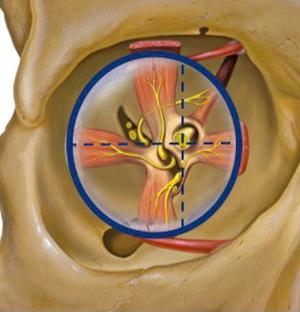
The medial intraconal space is divided into three conceptual compartments of increasing technical difficulty with regard to surgical approach ( Fig. 20.2 ):
Zone A: Anterior to the inferomedial muscular trunk of the ophthalmic artery and inferior to an imaginary line dividing the upper and lower half of the medial rectus muscle belly. It is the most favorable zone to approach due to its relative ease of access and the paucity of neurovascular structures. A branch of the inferior division of the oculomotor nerve inserts along the posterior third of the lateral aspect of the medial rectus muscle.
Zone B: Anterior to the inferomedial muscular trunk of the ophthalmic artery and superior to an imaginary line dividing the upper and lower half of the medial rectus muscle belly. Dissecting tumors within zone B is more challenging due to their proximity to the ethmoid vasculature and the occasional necessity to work above the medial rectus.
Zone C: Posterior to the inferomedial muscular trunk of the ophthalmic artery. This region is the most technically challenging to address due to its small volume and proximity to the optic nerve and ophthalmic artery.
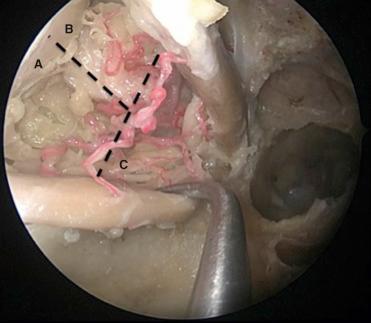
The inferior intraconal space contains branches of the oculomotor nerve to the inferior rectus and inferior oblique muscles.
The endoscopic approach may be considered for primary orbital tumors that lie medial to the optic nerve.
Tumors extending lateral to the optic nerve may be addressed via an endoscopic approach provided it lies beneath the “plane of resectability.” This plane may be drawn from the contralateral nare through the long axis of the optic nerve. Structures inferior to this plane may be safely dissected without requiring nerve retraction.
Tumors that lie lateral to the optic nerve or superior to the plane of resectability are currently not candidates for an exclusive endoscopic approach.
All patients should be evaluated by a multidisciplinary team, including an otolaryngologist and ophthalmologist. A neurosurgeon should also be involved if an adjunctive craniotomy approach or dural transgression is required.
A complete ophthalmologic physical examination should be performed, including formal visual field testing.
The natural history of the tumor should be considered.
The multidisciplinary team and the patient should discuss the goals of surgery, the approach, and the anticipated outcomes.
Computed tomography (CT) scan and magnetic resonance imaging (MRI) may be used for the following ( Figs. 20.3A and 20.3B ):
Evaluation of the relationship between the lesion and the surrounding bony and neurovascular structures
Evaluation of the course of the ophthalmic artery relative to the optic nerve (may be determined by the MRI)
Image guidance
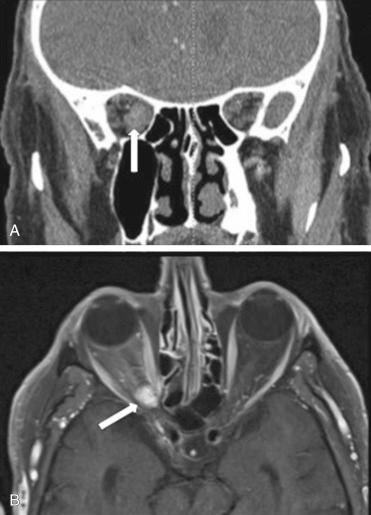
A three-dimensional (3D) reconstruction based on the CT and MRI provides the following ( Fig. 20.4 ):
Delineation of the relationship between the tumor and the course of the optic nerve
Accurate estimation of the tumor volume and morphology
Determination of the “plane of resectability,” which predicts the tumor volume lateral to the optic nerve that may still be resectable via an endoscopic approach
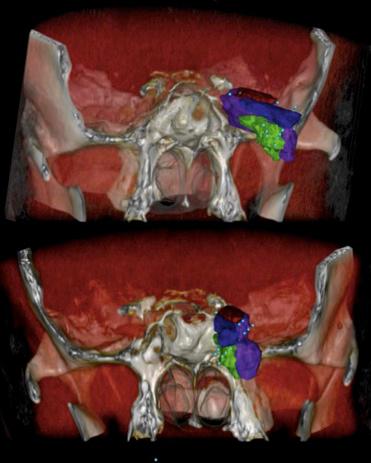
Angiography is not routinely required but may be useful if a vascular lesion or ophthalmic artery aneurysm is suspected.
The medial intraconal space is located lateral to a plane parallel to the lateral nasal wall. As such, the choice of instrumentation must include angled instruments and endoscopes to visualize and work within this space.
The initial approach to the medial intraconal space requires a complete functional endoscopic sinus surgery and thus requires all the instrumentation commensurate with this technique, which has been shown in previous chapters.
The bony resection of the lamina papyracea requires fine dissecting instruments, such as a cottle elevator and double-ball probe ( Fig. 20.5 ).
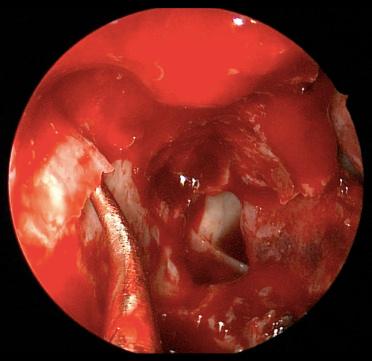
Removal of the thicker bone of the palatine and sphenoid bone requires an angled high-speed, 4-mm diamond bur ( Fig. 20.6 ).
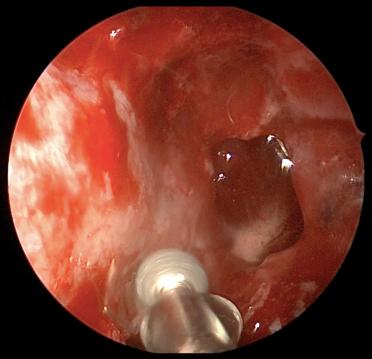
Following bone removal, the periorbita may be incised with a disposable sickle knife ( Fig. 20.7 ).
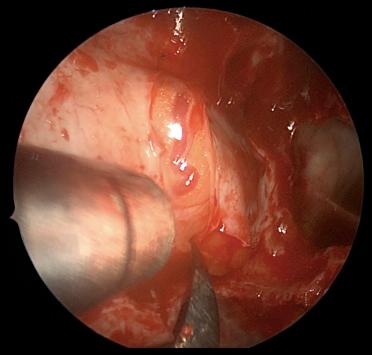
Dissection and retraction of the extraocular muscles may be achieved using a combination of the double-ball probe, Freer elevator, and angled Penfield dissector ( Fig. 20.8 ).
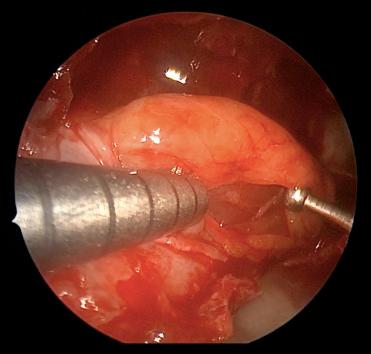
A ½- by 3-inch neuropatty may be used for retraction of orbital fat and diversion of blood ( Fig. 20.9 ).
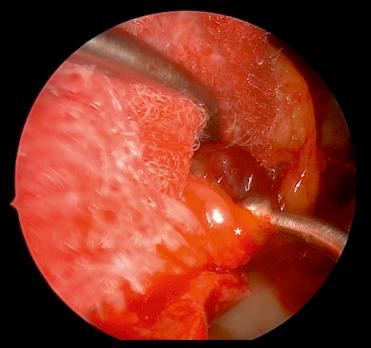
Once exposed and dissected out, the tumor may be grasped and removed with a small cupped forcep.
Become a Clinical Tree membership for Full access and enjoy Unlimited articles
If you are a member. Log in here